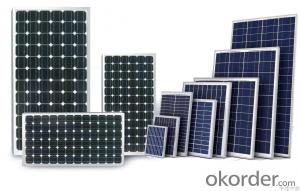250watt CNBM Solar Polycrystalline Series II (250W—260W)
- Loading Port:
- China main port
- Payment Terms:
- TT OR LC
- Min Order Qty:
- 10000 watt
- Supply Capability:
- 500000 watt/month
OKorder Service Pledge
OKorder Financial Service
You Might Also Like
Item specifice
CNBM Solar Polycrystalline Series II (250W—260W)
Characteristics
Max Power Voltage Vmp(V) | 30.1 | 30.4 | 30.5 |
Max Power Current Imp(A) | 8.31 | 8.39 | 8.53 |
Open Circuit Voltage Voc(V) | 37.4 | 37.5 | 37.6 |
Short Circuit Current Isc(A) | 8.83 | 8.86 | 8.95 |
Max Power Pm(W) | 250 | 255 | 260 |
Temperature Coefficient of Cells
NOCT | 45℃±2℃ | |
Temperature Coefficients of Isc (%/℃) | - 0.049 | |
Temperature Coefficients of Voc (%/℃) | –0.32 | |
Temperature Coefficients of Pmp (%/℃) | –0.43 | |
Mechanical Data
Dimension | 1638 x 982 x 40 mm | |
Weight | 19.5kg | |
No. of Cells and Connections | 60 (6 x 10) | |
Tolerance | 0~+5W | |
Cell Monocrystalline Cell | 156 x 156 mm | |
Packing | 700 Pcs/40ft(H) Container |
Limits
Operating Temperature | –40 °C to +85°C | |
Storage Temperature | –40 °C to +85°C | |
Max System Voltage | 1000VDC(IEC) / 600VDC(UL) | |
IV Curve

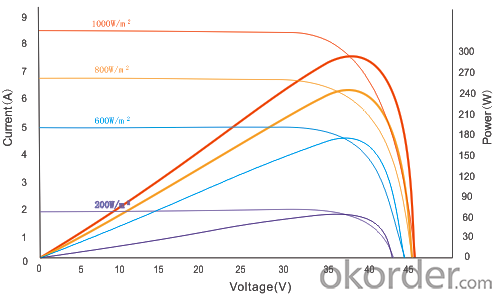
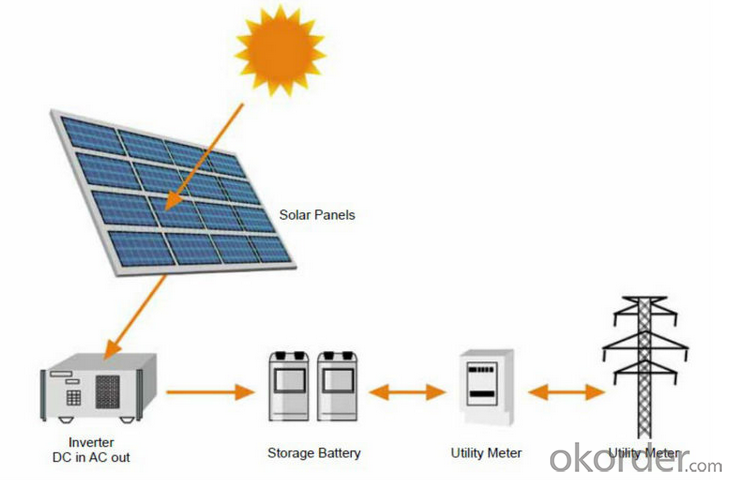
Image
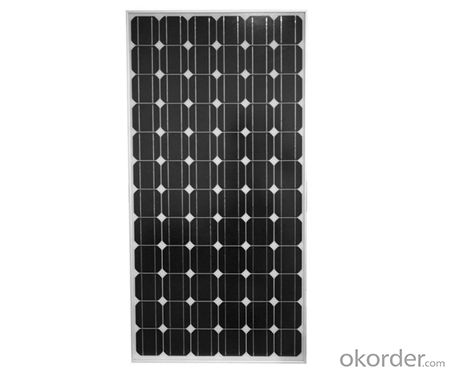
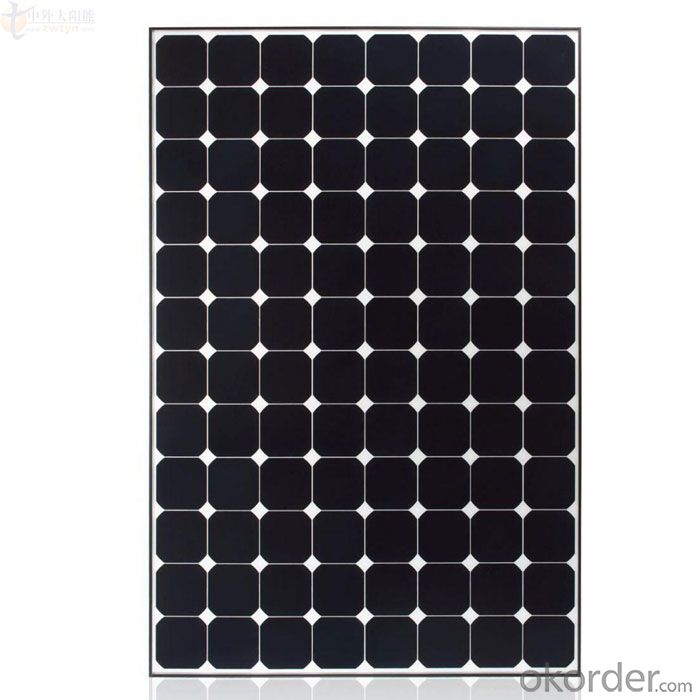
Guarantees
Products Guarantee 12 yrs free from defects in materials and workmanship
Performance Guarantee No less than 90% within 10yrs and no less than 80% within 25yrs
Certificates TUV (IEC61215&IEC61730), VDE(IEC61215&IEC61730), UL, CE
FAQ
1. Q: Do you have your own factory?
A: Yes, we have. Our factory located in Jiangsu province.
2. Q: How can I visit your factory?
A: Before you take off from your country, please let us know. We will show you the way, or arrange time to pick you up if possible.
3. Q: Do you provide free sample?
A: Usually we do not offer free sample
4. Q: Could you print our company LOGO on the nameplate and package?
A: Yes, we can do that.
- Q:If you buy everything you need for a grid-tied solar set up, can you install it yourself or is it required that a professional installs it?
- For safety purposes and liability, I do suggest that you should hire a professional solar panel installer. The solar panels has a lot of engineered like work, So better hire someone who has a fully aware for this work.
- Q:Can solar panels be installed on a barn or agricultural building?
- Yes, solar panels can be installed on a barn or agricultural building. In fact, these structures often provide ideal conditions for solar panel installation due to their large, unobstructed roofs and proximity to open spaces that receive ample sunlight. Installing solar panels on barns or agricultural buildings can help farmers and landowners generate renewable energy, reduce electricity costs, and contribute to a more sustainable future.
- Q:hey so im doing this project for my technology class and i was wondering what different colours solar panels can be. also is it possible to have kentic power as a back up power if batteries dont work? thx in advance
- Ours are all silver - we have them on a canal boat and on our house roof for water heating. I've not seen them in any other colour, but that doesn't mean they don't exist.
- Q:Can solar panels be used in agriculture?
- Yes, solar panels can be used in agriculture. They can provide clean and renewable energy to power various agricultural processes such as irrigation systems, livestock operations, and crop drying. Additionally, solar panels can be installed on farm buildings or in open fields, helping farmers reduce their reliance on traditional energy sources and lower their carbon footprint.
- Q:Are solar panels safe for the environment?
- Yes, solar panels are safe for the environment. They produce clean and renewable energy by converting sunlight into electricity without emitting harmful greenhouse gases or pollutants. Additionally, the manufacturing process of solar panels has become more sustainable over time, reducing their environmental impact.
- Q:do solar panels create electricity from the ultraviolet light created from the sun? because they only have an efficientcy of like 8% and this scientist found out a way to collect the visible light also, and he says the solar panel could have an effeciency of up to 80%! so my question really is, do solar penels creat electricity from heat? do you know of anything that can?
- Not many people realise it, but Einstein did not win the Nobel Prize for either Theory of Relativity. He was awarded the prize for his work on the photoelectric effect. i.e. the ability of some materials to take photons of light and turn their energy into electricity. Now, since most of the Sun's UV rays are filtered out by the Earth's atmosphere, else we'd be able to get a sunburn in seconds walking around outside in daylight, I think there is some energy imparted to the solar cells by UV wavelengths of light, but most solar cell materials rely on the wavelengths of electromagnetic radiation we call visible. Plus, I always thought infrared wavelengths conveyed more heat energy than UV rays.
- Q:Photo-Voltaic solar panels are very expensive. Most of a home's energy needs are for heating water, heating and air-conditioning. All of these can be met with thermal solar collectors which are much less expensive. The thermal solar panels would heat water stored in a hot water tank which then can be used as hot water, to heat the home, or as the heat source to a Lithium Bromide Absorption chiller to air-condition a home. With the base line needs met without expensive panels and without inefficient energy conversions, only a small Photo-Voltaic array would be needed for the remaining power needs and since those needs are variable, there would still be power to sell to the grid.
- you completely nailed it!! speaking about large buildings, it would benefit one to do a little more research. my company just installed a 640 collecter system on a million sq foot building. it consists of a absorption chiller (which uses no coolant, just water a silica gel beds, runs of the power of its controller, thats it) 27,000 gallon tank. chiller feeds 2 rotation units and 2 large office spaces for heat and cool. payback expected at less than 5 years. we will expand this system another 200 collectors. residential installs, if tax credits used, achieve 5-7 year payback pending domestic hot water only or dhw and space heating. thermal collectors actually produce more energy than pv panels do, therefore more bang for your buck, also as i hope you all know, pv has around 25% eff, thermal has 95%. also to say the tech part is gone, we use flowmeters that calculate carbon offsets, energy saved, money saved etc...all located in a wireless monitor for the consumer to enjoy.
- Q:I need a new roof soon and I was wondering what the difference in cost would be from a standard shingle roof to a roof including solar panels. Does anyone know the cost difference?
- The solar panels are very expensive to provide much power. If u go that way do not skimp on the support as a high wind will blow them away. In Ecuador I put in a remote site for communications. It was working good when a Strong wind blew $0.000 worth of solar panels all over the jungle.
- Q:Can solar panels be installed on a boat?
- Yes, solar panels can be installed on a boat.
- Q:Can solar panels be used for powering a telecommunications tower?
- Yes, solar panels can be used for powering a telecommunications tower. Solar panels convert sunlight into electricity, which can then be used to power various devices, including telecommunications equipment. This renewable energy option is sustainable and environmentally friendly, making it an increasingly popular choice for powering remote or off-grid telecom towers.
1. Manufacturer Overview |
|
|---|---|
| Location | |
| Year Established | |
| Annual Output Value | |
| Main Markets | |
| Company Certifications | |
2. Manufacturer Certificates |
|
|---|---|
| a) Certification Name | |
| Range | |
| Reference | |
| Validity Period | |
3. Manufacturer Capability |
|
|---|---|
| a)Trade Capacity | |
| Nearest Port | |
| Export Percentage | |
| No.of Employees in Trade Department | |
| Language Spoken: | |
| b)Factory Information | |
| Factory Size: | |
| No. of Production Lines | |
| Contract Manufacturing | |
| Product Price Range | |
Send your message to us
250watt CNBM Solar Polycrystalline Series II (250W—260W)
- Loading Port:
- China main port
- Payment Terms:
- TT OR LC
- Min Order Qty:
- 10000 watt
- Supply Capability:
- 500000 watt/month
OKorder Service Pledge
OKorder Financial Service
Similar products
New products
Hot products
Related keywords
